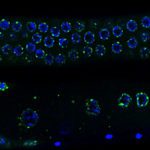Link to Pubmed [PMID] – 23263989
Mol. Cell. Biol. 2013 Mar;33(5):999-1015
Plant homeodomain (PHD)-type zinc fingers play an important role in recognizing chromatin modifications and recruiting regulatory proteins to specific genes. A specific module containing a conventional PHD finger followed by an extended PHD finger exists in the mammalian AF10 protein, among a few others. AF10 has mostly been studied in the context of the leukemic MLL-AF10 fusion protein, which lacks the N-terminal PHD fingers of AF10. Although this domain of AF10 is the most conserved region of the protein, its biological significance has not been elucidated. In this study, we used genetic and biochemical approaches to examine the PHD1-PHD2 region of the Caenorhabditis elegans ortholog of AF10, zinc finger protein 1 (ZFP-1). We demonstrate that the PHD1-PHD2 region is essential for viability and that the first PHD finger contributes to the preferred binding of PHD1-PHD2 to lysine 4-methylated histone H3 tails. Moreover, we show that ZFP-1 localization peaks overlap with H3K4 methylation-enriched promoters of actively expressed genes genomewide and that H3K4 methylation is important for ZFP-1 localization to promoters in the embryo. We predict that the essential biological role of the PHD1-PHD2 module of ZFP-1/AF10 is connected to the regulation of actively expressed genes during early development.
